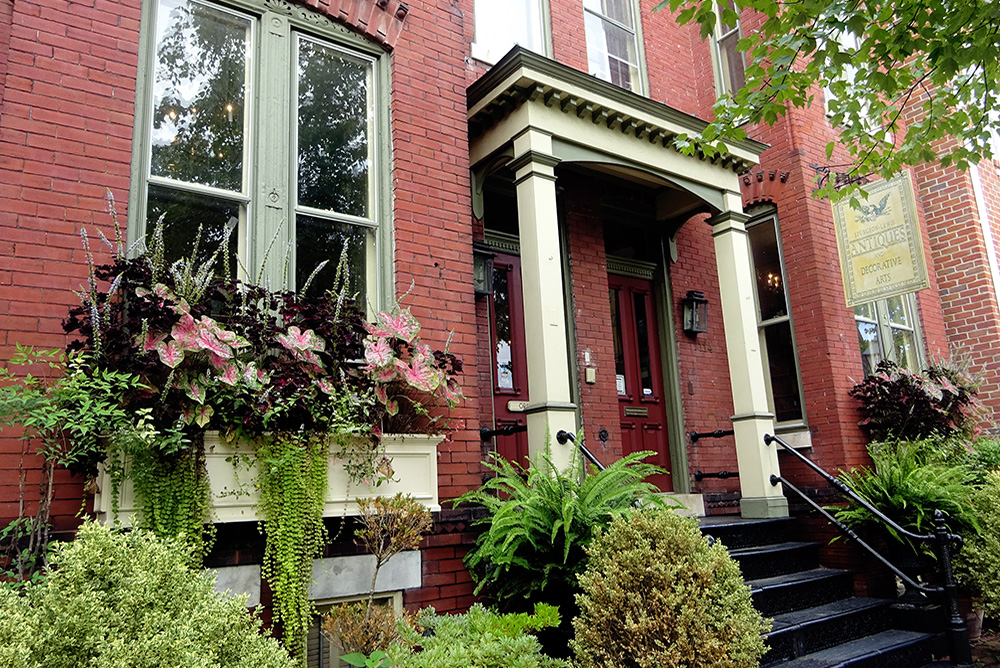
Fall abundance in Alexandria, Virginia. / Photo by Stephanie Cavanaugh.
IT WAS A WET Saturday, so what else is new. But then, some places are enhanced by damp in a sweetly gloomy way, like Paris or, in a pinch, Alexandria’s Old Town.
Traffic noises are muted as you face the brick and stone and wooden houses head on, drizzle fogging your eyes and blurring your mind, silvery rain droplets glistening on fine displays of greens and flowers in pots and window boxes.
Flanking the entry to Spurgeon-Lewis Antiques on North Columbus Street, a few steps from the bustle of King Street, sidewalk planters froth with greenery. Floating above them, a pair of window boxes, deep and elegantly trimmed, explode with plants. Blousy leaves of pale pink caladium, marbled with green and white striations, deep purple coleus, a straggly fringe of pink and purple fuchsia, and gentle beads of creeping Jenny trailing down the box fronts.
This is not a display to be ignored, I’m thinking.
“They look like hell,” snipped Paul Bavis, an associate with the shop who specializes in designing and building chandeliers for such places as the Maryland Governor’s mansion and Decatur House in Washington, DC. In his spare time, the shop’s plantings are his province.
Hauled upstairs from the cellar, a little disheveled from wrestling with crystals or whatever it was he was doing, he dismissed the window boxes as disorganized, “Next week, I’ll rip it all out.”
Well, gee. Sorry I liked them.
Glancing out the window he spies a woman, snapping a photo. “Look at her, taking pictures,” he said, cringing. Dare I say I did so too?
I’m telling you these boxes are inspirational.
A masterful gardener, Bavis tended his own greenhouse as a teenager, living in Atlanta. There he dabbled and grew strange and wonderful plants from sprigs and seeds. In Old Town, he selects plants that will be appropriate for this Victorian building. Like caladium and coleus, which withstand heat, and fuchsia, which usually performs well for him but did not take well to this past summer’s immoderate climate.
For maximum growth, you do need great big boxes, securely anchored. The shop’s wooden boxes fell apart earlier this year, “rotting from the outside in. It was alarming,” he said. Ringers for wood, these were custom made by his carpenter in vinyl. They can be painted and are nearly indestructible.
You also need a great deal of water, more than you might think could possibly be necessary. “Even if it’s raining, I water the pots and boxes every morning,” he said.
The fall renovation will involve heather, if he can find it, boxwood, mums and “violas, not pansies,” he said.
“Violas are lovely, so delicate,” I agreed. If I could have inserted a further opinion, I would have said they remind me of ladybugs in a swirl, subtler than pansies, their flashy big cousins.
The boxes will change again for the holidays, becoming more festive, and yet again around March, refreshed with spring bulbs and blooms.
There’s no reason for window boxes to go fallow for the winter.
Other than England, Bavis looks for inspiration to the 75-acre Ladew Topiary Gardens in Monkton, Maryland, the glorious 1,077-acre Longwood Gardens and conservatory in Wilmington, Delaware, and, closer to home, the gorgeously manicured Enid Haupt Gardens that front the Smithsonian Castle on Washington’s Mall.
We agree that it’s impossible to come away from any of these without fingers itching to dig, to grow, to combine curious plants, colors and textures.
Window boxes, particularly, lend themselves to experimentation, playfulness. Unlike replacing a garden bed—or a chandelier, for that matter—if the box doesn’t please you, it’s short work and minimal expense to effect a complete transformation.
Next week these will be an ode to fall, and no doubt a fabulous one.
—Stephanie Cavanaugh
LittleBird “Stephanie Gardens” reports every Thursday on greenery.
